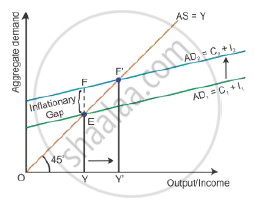Advertisements
Advertisements
Question
Explain the concept of 'excess demand' in macroeconomics. Also explain the role of 'open market operation' in correcting it.
Solution
Excess demand occurs in a situation when aggregate demand is more than aggregate supply corresponding to full employment. It leads to reduction in inventories and inflation in the economy. This situation is considered an inflationary gap—the difference between aggregate demand beyond full employment and aggregate demand at full employment. Aggregate demand is the AD curve and aggregate supply is the AS curve (as shown in the diagram below). While the aggregate demand curve and the aggregate supply curve intersect each other, the full employment equilibrium is attained at Point E. OY is the full
employment level of output, and EY is the aggregate demand at full employment level of output. If the aggregate demand increases beyond the full employment level of output from EY to FY, then the economy will have excess demand, i.e. situation of inflationary gap (FY − EY = FE).

Role of open market operation to curb the excess demand:
Open market operations refer to the sale and purchase of government securities and bonds by the central bank. While controlling inflation, the central bank sells government
securities to the public through the banks. This results in the transfer of a part of bank deposits to the central bank account and reduces credit creation capacity of the commercial banks.
APPEARS IN
RELATED QUESTIONS
What is aggregate supply?
Given consumption curve, derive saving curve and state the steps taken in the process of derivation. Use Diagram.
Explain national income equilibrium through aggregate demand and aggregate supply. Use diagram. Also explain the changes that take place in an economy when the economy is not in equilibrium
What is aggregate demand?
Explain how government spending can be helpful in removing deficient demand.
Define aggregate supply?
explain the role of Bank Rate in correcting deficient demand?
Explain the role of 'Open Market Operations' in reducing Deflationary Gap
Fill in the blank with appropriate alternatives given below
That part of income, which is not spent on consumption, is called __________.
Distinguish between:
Aggregate Demand and Aggregate Supply
Answer the following question:
What are the determinants of Aggregate Demand (AD)?
Answer the following question:
What are the determinants of Aggregate Supply (AS)?
State with reason whether you agree or disagree with the following statement.
Aggregate supply is influenced by the state of technology only.
State with reason whether you agree or disagree with the following statement.
Positive net earnings from foreign transactions add to aggregate demand.
Answer in detail.
What is Aggregate Supply? Explain the determinants of Aggregate Supply.
Write explanatory answer.
What is 'aggregate supply'? Explain the determinants of aggregate supply.
In a closed economy, aggregate demand is the sum of ______.
An increase in aggregate demand of equilibrium level of income and employment causes an increase in ______
“In an economy Planned spending is more than Planned output”.
Explain its impact on the level of output, income and employment.
If planned savings exceeds planned investments in an economy, explain its likely impact on income, output and employment.
